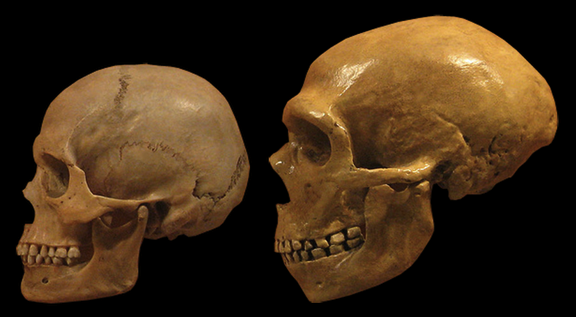Comparison of Modern Human and Neanderthal skulls from the Cleveland Museum of Natural History. Credit: DrMikeBaxter/Wikipedia
A team of researchers affiliated with multiple institutions in the U.K. and one in Germany has found evidence of interbreeding between Neanderthals and modern humans on Jersey island. In their paper published in Journal of Human Evolution, the group describes their study of teeth found at La Cotte de St Brelade, a cave on the southwest side of the island, back in 1911.
Jersey island is located off the northwest coast of France—prior research has shown that Neanderthals had been living in the cave as far back as 250,000 years ago. Prior research has also shown Neanderthals first came to exist in parts of Europe and Siberia approximately 400,000 years ago. Modern humans are thought to have traveled to Europe approximately 40,000 years ago—5,000 years later, the Neanderthals were gone.
In this new effort, the researchers focused their effort on two teeth found on a small granite ledge in the cave in 1910 or 1911. At the time of their discovery, it was assumed the teeth, like so many others in the cave, were Neanderthal. In taking a new look at the teeth using computed tomography, the researchers found evidence of human-like differences from Neanderthals. The neck of the teeth were shaped like those of modern humans, but they also lacked the transverse crest of Neanderthal teeth. This suggested that the teeth came from the offspring of both a Neanderthal and a modern human. It also suggests that the teeth may represent some of the most recent remains ever found of a Neanderthal. The researchers also found that the two teeth belonged to two individuals—prior researchers had assumed they came from the same individual. The teeth were also dated to 48,000 years ago.
The researchers suggest that interbreeding between modern humans and Neanderthals was more common than thought. The study also hints at the possibility that Neanderthals never went extinct at all, but were instead subsumed into the human genome. Prior research has suggested that the genome of modern non-African people is approximately 2% to 3% Neanderthal. The study is also the first to show interbreeding between modern humans and Neanderthals in such a western part of Europe.
More information: Tim Compton et al. The morphology of the Late Pleistocene hominin remains from the site of La Cotte de St Brelade, Jersey (Channel Islands), Journal of Human Evolution (2021). DOI: 10.1016/j.jhevol.2020.102939
Journal information: Journal of Human Evolution
© 2021 Science X Network
























